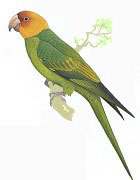
Dimdima
Online Children's Magazine from India

Dimdima
Online Children's Magazine from India
By Rani Iyer

The extinction of Carolina Parakeet
All modern extinctions have a story. It is usually the story of the thoughtlessness of human beings who overexploit plants and animals for their benefit. The carolina Parakeet, Conuropsis carolinensis, the only native parrot to continental North America, has a similar tale. This parakeet is colorful, with a yellow head, orange cheeks, and green body.
The Carolina Parakeet inhabited deciduous forests and forest edges. It nested in tree cavities. Fruits and seeds of trees were their main source of food. They also ate seeds and fruits of other plants like thistles and cockleburs. In the breeding season, the parakeets roamed about in pairs.
However, outside of the breeding season, they formed large, noisy flocks that fed on cultivated fruits, corn and other grain crops, and tore open apples to get the seeds. Soon they were considered serious pests and the farmers went after them with a vengeance.
As settlers occupied more areas, forests were cleared and large trees, including those, which had cavities, were cut down. A combination of factors; habitat loss, destruction of nesting sites, hunting the birds for their bright feathers and meat, and finally the wrathful farmers, all contributed to the decline of the bird. They were also sold as pets. By 1800, the parakeet was becoming a rare sight. The range of the bird was soon restricted to Florida around 1860. However, after several searches failed to find the bird in its original range, a flock of 30 birds were located in Florida in 1920. Soon the bird became extinct. Today we have only specimens of the Carolina Parakeet to study in the museums.
Last updated on :3/10/2004
EXPLORE MORE...
COMMENT ON THIS ARTICLE
Wants to share something related to this article? Please use the form below.
Dimdima is the Sanskrit word for ‘drumbeat’. In olden days, victory in battle was heralded by the beat of drums or any important news to be conveyed to the people used to be accompanied with drumbeats.
Bharatiya Vidya Bhavan
K. M Munshi Marg,
Chowpatty, Mumbai - 400 007
email : editor@dimdima.com
Bharatiya Vidya Bhavan
505, Sane Guruji Marg,
Tardeo, Mumbai - 400 034
email : promo@dimdima.com
Dimdima.com, the Children's Website of Bharatiya Vidya Bhavan launched in 2000 and came out with a Printed version of Dimdima Magazine in 2004. At present the Printed Version have more than 35,000 subscribers from India and Abroad.